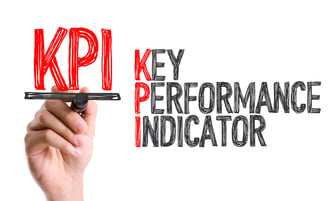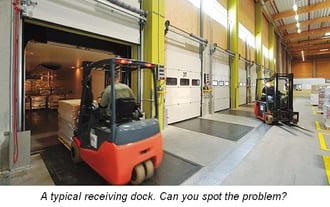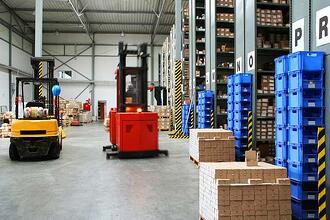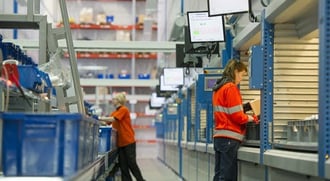
An efficient warehouse is a profitable warehouse, but it can be tricky to gauge how efficient your workplace pipeline is. You need to track traffic in and out, orders, and everything in between. You might already have a system in place to review your warehouse effectiveness, but an easy way to improve your performance is to review the little details.
This is where Key Performance Indicators come into play, or “KPIs” for short. Key Performance Indicators track specific aspects of your business in the same way you might go through employee evaluations or financial reports. But what are some examples of KPIs, and how can you use them to fine-tune your warehouse’s efficiency? Let’s take a look at some examples and see how they can help you improve your productivity and profitability.
Review Your General Warehouse KPIs
 Before getting into the nitty-gritty of warehouse management, let’s start at the ground floor with general warehouse KPIs. These are key factors that will impact most aspects of your business, and checking on these can help you narrow down your search for areas to improve.
Before getting into the nitty-gritty of warehouse management, let’s start at the ground floor with general warehouse KPIs. These are key factors that will impact most aspects of your business, and checking on these can help you narrow down your search for areas to improve.
For example, take Backorder Rate, which shows if you are having difficulty fulfilling placed orders; solving problems here keeps your customers happy and keeps business rolling in. You can also tighten your search pattern by looking at your Perfect Order Management, which can reveal breakdowns in the different phases of the supply chain (such as procurement, production, transportation, or labor).
Reviewing general warehouse KPIs can also give you some insight into your customer base. Determining your Demand Forecast makes managing your pricing and capacity more efficient, and it can also indicate if it’s time to expand your warehouse’s operations. Rate of Return does the opposite, helping you gauge why customers return products and how to prevent too many returns in the future. You can also track Days Sales Outstanding, which can improve customer relations and make your accounts receivable department more efficient.
Review Your Receiving and Putaway KPIs
 When you first get inventory shipped in for storage, you’ve got a golden opportunity to improve the productivity of your whole warehouse by adjusting your storage and processing methods. You can measure Time to Receiving and Pick Location directly to see how quickly and efficiently your staff processes new inventory. After you’ve received new stock, tracking Receiving Cycle Time lets you measure how swiftly your stock is counted, recorded, and prepared for storage. Even then, you can hone your workflow further by looking into your Putaway Accuracy Rate, which itself impacts your inventory KPIs. Speaking of which…
When you first get inventory shipped in for storage, you’ve got a golden opportunity to improve the productivity of your whole warehouse by adjusting your storage and processing methods. You can measure Time to Receiving and Pick Location directly to see how quickly and efficiently your staff processes new inventory. After you’ve received new stock, tracking Receiving Cycle Time lets you measure how swiftly your stock is counted, recorded, and prepared for storage. Even then, you can hone your workflow further by looking into your Putaway Accuracy Rate, which itself impacts your inventory KPIs. Speaking of which…
Take Inventory of Your Operation with Inventory KPIs
 Even before shipping goods, there’s no shortage of places in inventory where you can improve productivity. After all, you have to know what inventory you have before you can move any of it. At this point, you might want to factor in Inventory Accuracy; if you don’t have an accurate record of what’s in your inventory, you run the risk of losing customers whose demands can’t be met. If your operation is large enough, you might need specialized software or equipment to help you track inventory. Additionally, you’ll also need to track Inventory Turnover, which describes how often your warehouse goes through its entire stock; this also includes Days on Hand, since keeping inventory moving is as important as having resources available.
Even before shipping goods, there’s no shortage of places in inventory where you can improve productivity. After all, you have to know what inventory you have before you can move any of it. At this point, you might want to factor in Inventory Accuracy; if you don’t have an accurate record of what’s in your inventory, you run the risk of losing customers whose demands can’t be met. If your operation is large enough, you might need specialized software or equipment to help you track inventory. Additionally, you’ll also need to track Inventory Turnover, which describes how often your warehouse goes through its entire stock; this also includes Days on Hand, since keeping inventory moving is as important as having resources available.
In addition to streamlining your inventory’s organization, inventory KPIs also shed light on your sales data. By tracking your Inventory to Sales Ratio, you can accurately assess how your company’s doing in the current economy; couple this with some predictive algorithms, and you can even improve your sales figures. Of course, you’ll also need to factor in your Carrying Cost of Inventory when making any predictions about sales using your inventory, since this KPI weighs your ability to move and sell inventory against your financial ability to store it.
Picking, Packing and Shipping More Efficiently with KPIs
 At the end of the day, you need to move your inventory to make a profit, so tightening up the ways you move stock out of your warehouse directly impacts your business’s performance. Picking is one of the more complicated parts of shipping, so using Picking KPIs to improve the process is ideal. Track Orders Picked Per Hour to see how efficient different teams of staff are at picking inventory, and track Order Picking Accuracy to keep your customers happy. The closer you can get your accuracy to 100%, the better.
At the end of the day, you need to move your inventory to make a profit, so tightening up the ways you move stock out of your warehouse directly impacts your business’s performance. Picking is one of the more complicated parts of shipping, so using Picking KPIs to improve the process is ideal. Track Orders Picked Per Hour to see how efficient different teams of staff are at picking inventory, and track Order Picking Accuracy to keep your customers happy. The closer you can get your accuracy to 100%, the better.
Still, that’s only half the battle, and once you’ve picked your stock, you have to pack and ship it. Making sure you’ve got a short Truck Time at the Dock means your inventory isn’t backing up, and keeping Cost Per Line Item Shipped low impacts your profitability. You can also keep costs down by making sure that your Freight Cost Per Unit is low since higher transportation costs mean more money spent overall.
Be Cautious About Warehouse Safety KPIs
 Everything we’ve talked about so far has been your warehouse’s efficiency KPIs, but your warehouse isn’t made up of only inventory. If you’re looking to improve your workplace’s performance, you’ll need to get serious about the safety of your workers too. Thankfully, there are quite a few safety KPIs that can help you assess the safety of your workplace. Your Warehouse Accident Rate should hopefully be zero, but by tracking it, you can ensure that your warehouse is a safer place to work. On the other hand, you can also track Time Since Last Accident, where the higher the number is, the safer your warehouse is.
Everything we’ve talked about so far has been your warehouse’s efficiency KPIs, but your warehouse isn’t made up of only inventory. If you’re looking to improve your workplace’s performance, you’ll need to get serious about the safety of your workers too. Thankfully, there are quite a few safety KPIs that can help you assess the safety of your workplace. Your Warehouse Accident Rate should hopefully be zero, but by tracking it, you can ensure that your warehouse is a safer place to work. On the other hand, you can also track Time Since Last Accident, where the higher the number is, the safer your warehouse is.
Keeping Organized
When it comes to improving the performance of your warehouse, there’s no shortage of metrics to track. The devil’s in the details, and there’s no singular factor that dictates the performance of your business. By utilizing KPIs to keep your workplace fast, efficient, accurate, and safe, you make sure that your warehouse is the best that it can be.